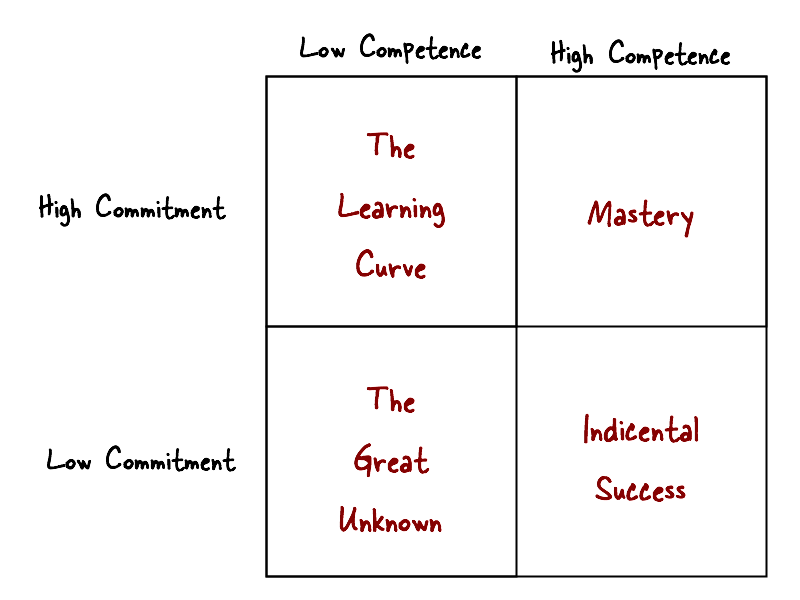Now answer this question:
Is it because you couldn’t, you didn’t really want to, or both?
This question speaks to the two primary components that lead to success in business and in life – commitment and competence. Commitment is your “want to” – the amount of desire and willingness you bring to your project or creation. Competence is your “how to” – the amount of skill and capability you are currently able to harness.
Here’s a simple way of looking at how these two elements combine to create our experience of creating (or failing to create) what we want:

I. Low Commitment/Low Competence:
THE GREAT UNKNOWN
Something you aren’t particularly good at and don’t particularly care about may seem to be irrelevant, and it very often is. However, this quadrant can also be the gateway to a whole new experience of whole aspects of your life.
What holds us back in life is rarely the problems we know about and are actively attempting to solve – it’s what we don’t know that we don’t know. That doesn’t mean you have to delve into everything in order to learn something; just that an active curiosity and a greater comfort with the unknown will serve you well, regardless of what you choose to do with your life-time.
II. Low Commitment/High Competence:
INCIDENTAL SUCCESS
I remember having a conversation with a friend once about what he was going to do “when he grew up”. He said he would probably continue to work in the software industry, despite the fact that he didn’t particularly like it.
When I asked him why, he said “because I’m good at it and it pays well.”
It’s surprising how many of my clients have become successful at something they don’t really care about; it’s equally surprising how few of them have seriously considered basing their life and career decisions around what they would actually love to do. Once they do, they step onto…
III. High Commitment/Low Competence:
THE LEARNING CURVE
The larger the gap between our “want to” and our skill set, the steeper the learning curve and the more we enjoy riding it. We oscillate between overwhelm and pure flow as we rise up to meet the challenges of learning what we need to learn in order to live the life we want to live. Of course, if we don’t recognize the need to develop the relevant skills or competencies, we’re liable to fall off the curve altogether.
But when we do put both elements together, we move into the final quadrant…
IV. High Commitment, High Competence:
MASTERY
When our commitment and competency are both at their peak, we experience and demonstrate mastery in our endeavors. It’s not that things never go wrong or always work out – just that we are able to respond well to change and our best is often more than enough to create the results we want.
With mastery, things often look effortless, and can feel that way too. This is not because there’s no actual effort involved, but rather that there’s no “efforting” – no need to strive or struggle in order to succeed.
To help yourself understand each of these quadrants in relation to your Impossible Project, fill in the chart below with a few activities, goals, or projects that fit into each one:

If you’re not sure that you “want to”, check to see if this really is your project or if it’s someone else’s dream placed in your hands. Authentic desire doesn’t need to be created. It can simply be uncovered, one limiting belief at a time, and given space to breathe and to grow.
On the other hand, if all that’s missing is the “how to”, your job is even easier. Simply jump back onto the learning curve, fail until you start to succeed, and enjoy the ride!
With all my love,
![]()










